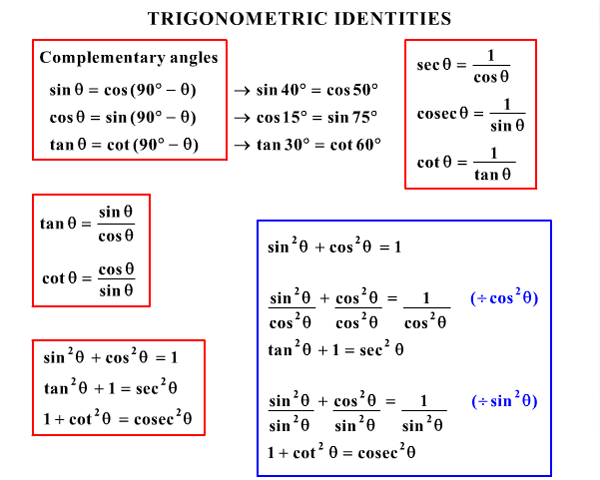Thursday, December 11, 2014
Law of Sines/Cosines
Law of sine is used when given at least 2 sides and one angle, or given 2 angles and one side. Law of cosine is used when given three sides, or three angles, or one angle and two sides. When we solve a problem, we better just use law of cosine one. And continue the problem using law of sines. Because the law of cosine is more complicated than law of sine, we can avoid unassary calculation errors by choosing a simpler method. Law of sines is that the fraction of one side and it's opposite angle is proportional to the other set of angle and side. Law of cosine is a^2=b^2+c^2-2bc CosA. And same for solving other sides.
Tuesday, December 9, 2014
Chapter 4 Summary
In the beginning of chapter 4, we talked about angle measurements. We learned how to convert between degrees, minutes and seconds. We reviewd about complementary and supplementary angles. We learned about unit circle. And trigonometric identities, sine, cosine and tangent. We learned how to graph them. We also learned special angles' values. In chapter4.5, we learned about verifying trig identities. And then we learned how to use identities to solve trig equations.
Mr. Unit Circle.
The unit circle has a radius of 1. Because the radius is one, we can measure sine,cosine, and tangent. The Pythagoras theorem is a^2+b^2=c^2, it only works for right triangles. When we solve trig problems, unit circle is extremely helpful. It saves up a lot of time. Triangles constructed on the unit circle can also be used to illustrate the periodicity of the trigonometric functions. The interior of the unit circle is called the open unit disk, while the interior of the unit circle combined with the unit circle itself is called the closed unit disk. I like unit circles because they make things easy.
Monday, December 8, 2014
Trigonometric Equations
To solve trigonometric equations: 1. combine all th elike terms. 2. collect trig terms on one side and constant on one side. 3. apply a trig identity if applicable. 4. factor if possible. 5.isolate trig function. 6. solve for variable. i dont like solving trig equation, because they are so hard, and they hurt my brain,,,,,,,,

Verifying Trig Identities
when we try to verify a trig identities, we first simplify the more complicated side. 2. find the common denomenators. 3. change all trig functions in terms of sin and cos. 4. use an identity to verify. when we are stuck at certain point, we should try to use another way to approach the problem rather than keeping struggling.there are various ways to verify trig functions.i like doing those problems, because they are torturing my mind.


tangent
tangent has a function y=Atan(Bx+c)+D. tangents are undefined at 90 and 270 degree. has asymptotes at pi/2 and 2pi/2. the period of tangent graph is pi/B. cotangent occurs at asympyotes of tangent graph. i dont understand how to calculate the vertical asymptotes of tangent graphs.


Thursday, December 4, 2014
Sine and cosine
Sine is using the opposite side dived by the hypotenuse. Cosine is using the adjacent side divided by the hypotenuse. When we solve a triangle, it is really helpful to use sine cosine and tangent. When we draw a graph for sine and cosine, the basic equation is y=ASine or Cosine (Bx+C)
Subscribe to:
Posts (Atom)



